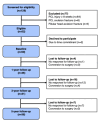Long-term Follow-up of Patients with Acute Posterior Cruciate Ligament Injury Treated Non-operatively with a Physiotherapy-led Exercise and Support Brace Intervention
- PMID: 40322513
- PMCID: PMC12048365
- DOI: 10.26603/001c.134128
Long-term Follow-up of Patients with Acute Posterior Cruciate Ligament Injury Treated Non-operatively with a Physiotherapy-led Exercise and Support Brace Intervention
Abstract
Background: Posterior Cruciate Ligament (PCL) injuries can be treated non-operatively with a structured rehabilitation program or by surgical reconstruction. However, while the outcomes of surgically treated PCL injuries are well described, there is a paucity of large prospective studies reporting long-term outcomes of exercise interventions.
Purpose: The primary aim was to investigate long-term (after five years) patient-reported outcomes of a physiotherapy-led exercise and support brace intervention in patients with an acute PCL injury. The secondary aim was to report conversion to surgical PCL reconstruction.
Study design: Case series study, prospective.
Methods: Fifty patients with acute isolated or multiligament PCL injuries (presenting within eight weeks of injury) completed a 16-week exercise intervention, including 12 weeks in a PCL support brace. Patients were followed prospectively, and patient-reported outcomes were assessed using the International Knee Documentation Committee Subjective Knee Form (IKDC), the Knee injury and Osteoarthritis Outcome Score (KOOS) and the Tegner Activity Scale (TAS). In addition, conversion to surgery was retrospectively extracted from medical records.
Results: Thirty-six patients completed subjective questionnaires at the five-year follow-up. The mean IKDC score improved from 35 points at baseline to 79 points at the five-year follow-up. All mean KOOS subscale scores increased by a statistically significant amount from baseline to the five-year follow-up: Symptoms: 52/87 points; Pain 56/88 points; Activities of daily living 58/90 points; Sport/Recreation 17/75 points; Quality of life 23/73 points. The TAS improved from level 2 at baseline to level 5 at the five-year follow-up. Seven patients (14%) were converted to PCL surgical reconstruction. The median time from initiation of non-operative treatment to surgery was 13 months (range 10-14 months).
Conclusions: The physiotherapy-led exercise and brace intervention showed statistically significant improvements in patient-reported outcomes at long-term follow-up of five years, and the need for conversion to PCL reconstruction for isolated PCL injuries was low with a conversion rate of 7%.
Level of evidence: 3b.
Keywords: changes in patient-reported outcomes; non-operative treatment; physiotherapy; progressive exercises; self-reported outcome.
© The Author(s).
Figures






Similar articles
-
Patient-reported Outcomes and Muscle Strength after a Physiotherapy-led Exercise and Support Brace Intervention in Patients with Acute Injury of the Posterior Cruciate Ligament: A Two-year Follow-up Study.Int J Sports Phys Ther. 2023 Aug 2;18(4):807-819. doi: 10.26603/001c.83214. eCollection 2023. Int J Sports Phys Ther. 2023. PMID: 37547839 Free PMC article.
-
Posterior cruciate ligament reconstruction with independent internal brace reinforcement: surgical technique and clinical outcomes with a minimum two year follow-up.Int Orthop. 2022 Sep;46(9):2019-2028. doi: 10.1007/s00264-022-05448-4. Epub 2022 May 26. Int Orthop. 2022. PMID: 35616654 Free PMC article.
-
Outcomes After Posterior Cruciate Ligament (PCL) Reconstruction in Patients With Isolated and Combined PCL Tears.Orthop J Sports Med. 2017 Apr 10;5(4):2325967117700077. doi: 10.1177/2325967117700077. eCollection 2017 Apr. Orthop J Sports Med. 2017. PMID: 28451615 Free PMC article.
-
The use of the ligament augmentation and reconstruction system for posterior cruciate ligament reconstruction in isolated and multiligament knee injuries: A systematic review.Knee. 2021 Jun;30:322-336. doi: 10.1016/j.knee.2021.04.008. Epub 2021 May 21. Knee. 2021. PMID: 34029853
-
Lysholm and KOOS QoL Demonstrate High Responsiveness in Patients Undergoing Anterior Cruciate Ligament Reconstruction: A Systematic Review and Meta-analysis of Randomized Clinical Trials.Am J Sports Med. 2024 Oct;52(12):3161-3166. doi: 10.1177/03635465231219966. Epub 2024 Feb 14. Am J Sports Med. 2024. PMID: 38352999
References
-
- Evaluation and treatment of posterior cruciate ligament injuries. Harner C. D., Höher J. 1998Am J Sports Med. 26(3):471–482. doi: 10.1177/03635465980260032301. https://doi.org/10.1177/03635465980260032301 - DOI - DOI - PubMed
-
- Minimum 10-year follow-up of patients after an acute, isolated posterior cruciate ligament injury treated nonoperatively. Shelbourne K. D., Clark M., Gray T. 2013Am J Sports Med. doi: 10.1177/0363546513486771. https://doi.org/10.1177/0363546513486771 - DOI - DOI - PubMed
-
- Isolated posterior cruciate ligament tears: An update of management. Vaquero-Picado A., Rodríguez-Merchán E. C. 2017EFORT Open Rev. 2(4):89–96. doi: 10.1302/2058-5241.2.160009. https://doi.org/10.1302/2058-5241.2.160009 - DOI - DOI - PMC - PubMed
-
- Isolated posterior cruciate ligament injuries in athletes. Fowler P. J., Messieh S. S. 1987Am J Sports Med. 15(6):553–557. doi: 10.1177/036354658701500606. https://doi.org/10.1177/036354658701500606 - DOI - DOI - PubMed
LinkOut - more resources
Full Text Sources
Research Materials
